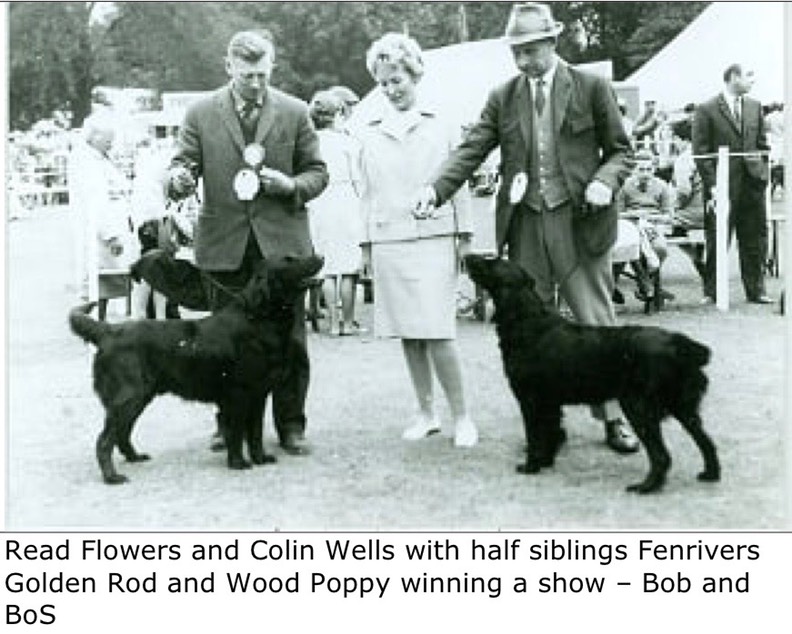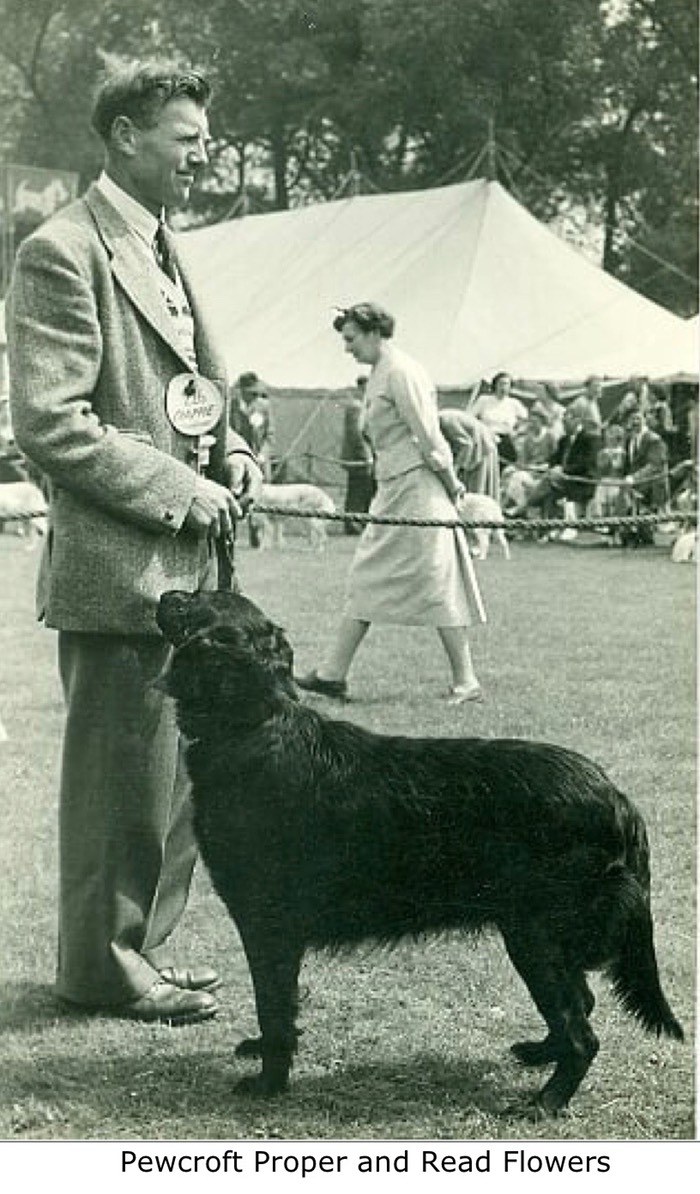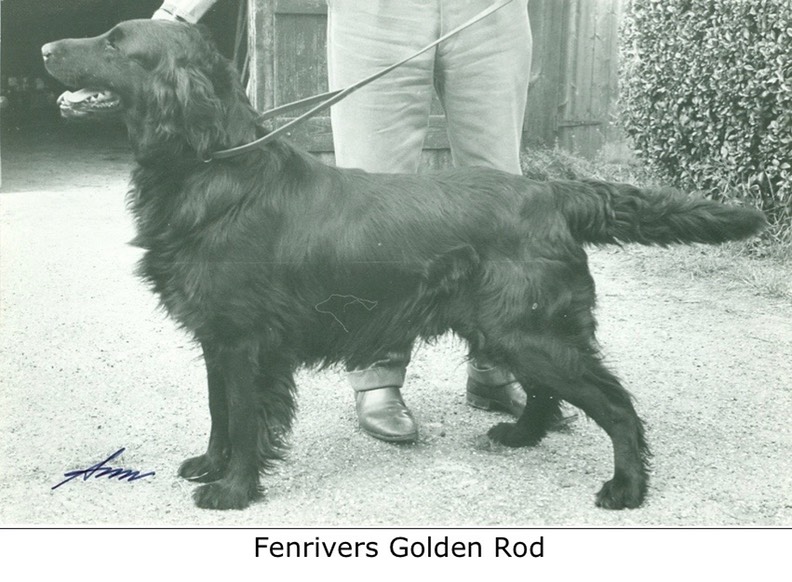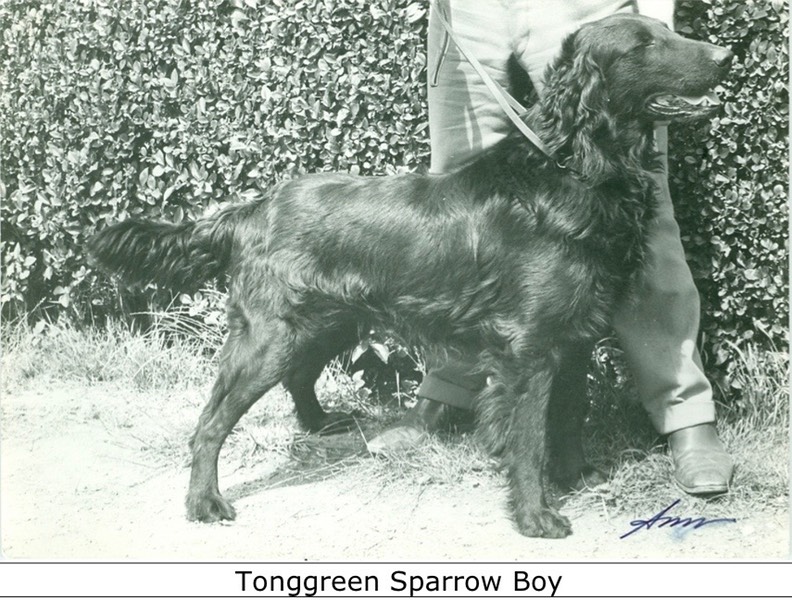Introduction by Ingemar Borelius
Mr Read Flowers, Fenrivers, was no doubt one of the major breeders during the restoration years after World War II. His dogs had a major impact on the development of the modern show Flatcoat. Fenrivers Golden Rod and his son Tonggreen Sparrowboy were the best winning show dogs of their generation being best of breed at Crufts numerous times. They had a huge impact at stud, producing numerous (show) champions and being strongly targeted for linebreeding. And although Read recommended breeders not to linebreed to Sparrow Boy, due to his initial unwillingness to retrieve game spontaneously and his somewhat reserved/untypical manners, he was targeted for a heavy linebreeding due to his looks. His line appears numerous times behind most (all?) top winning show Flatcoats today.

It’s an irony of fate that he appears close behind some of the very best working Flatcoats as well inheriting a placid attitude, biddability and a more reserved attitude towards other humans than is normally seen in a Flatcoat. In several cases he could obviously provide a good mental balance when combined with working Flatcoats showing drive and perseverance but a more headstrong and excitable attitude in the dialogue with their handlers.
Looking backwards he wasn’t one of those great breeders like O’Neill, Nancy Laughton, Colin Wells and Patience Lock who continuously produced first class stock for many other breeders. But I believe he had an eye that was second to none when it came to picking the best in a litter. Like many others from the foundation generation he turned his eyes gradually towards the working side of the breed. As it seems he focused on keeping good stud dogs and it’s obvious when looking at his long line of dogs that they were bred primarily for work. Starting with his favourite Fenrivers Ling, Downstream Nimble (sired by F. Nuphar, litter brother of Ling), Barras Beau of Fenrivers, Fenrivers Reedmace and Littleygreen Potter of Fenrivers, all in direct male line, they all came from 100 % working breeding.
These dogs were primarily used at stud by many of those quite anonymous pro work breeders who are just producing two or three litters under their prefixes, mainly for themselves. Some of these are probably game keepers, they are seldom seen at working tests or Field Trials but they are keeping the British working lines going.
In parallel to his long breeder career Read Flowers held different leading positions in the Flatcoated Retriever Society and he was a popular judge.
This interview was published at first 1982 in the Swedish Flatcoated Retriever Club Newsletter.

“I was born in a farmer’s home so my parent’s dogs were used at the farm for shooting and hunting. When I was a little boy my father had a few Flatcoats and my mother had a terrier to be used as a rat killer at the farm. My favourite uncle bred, showed and worked Clumber Spaniels and Gordon Setters. He was a well-known show judge as well so you could understand my destiny was to become a dog man one way or the other.
My father and I had a bunch of Flatcoats during the thirties but when I came home from Army services in 1947 these dogs were too old so I had to look for a pup to get started again. Flatcoats were not so common at that time so I went down to Crufts and bought a bitch from Mr Stanley O’Neill, to become the foundation of my kennel. She became a Champion and she left two Champions, Adonis and Asperula, and a Field Trial winner, Alyssum, all being sired by Waterboy, Colin Wells wonderful dog. Her name was Pewcroft Proper and I’m most thankful to Mr O’Neill for selling her to me and for all the advice he gave when I needed it the most.
Alyssum was mated to Atherbram Pedro to produce Fenrivers Evergreen. She won a certificate at a show and two Field Trial prices. She was mated to Colin Wells Woodlark to produce Fenrivers Golden Rod, the best show dog I ever had. He won twelve certificates and of those five at Crufts. He got prices as well from Field Trials, he was a very good gundog, sound, strong and persevering. His most well-known son was Tonggreen Sparrow Boy, winning numerous certificates and two Field Trial prices. He was a good dog but he had a rather reserved manner, quite untypical for a Flatcoat. His mother was Tonggreen Swift and he was bred by Miss Joan Chester Perks.
Then I had Heronsflight Sedge from Mrs Joan Mason. She was sired by Sparrow Boy and out of Heronsflight Black Bell of Yarlaw. She was a good worker and produced some useful pups with Nancy Laughton’s great worker Claverdon Gaff. I kept Fenrivers Ling, my great favourite, winning two certificates and a Field Trial. He was a smashing gundog but he died unfortunately at four years of age.

Today I’ve got his daughter, the liver bitch Wizardwood Brown Owl, being bred by Mrs Foster out of Windgather Delia of Wizardwood. She is a good one winning her title easily although she has been shown very few times. I own his daughter as well, Fenrivers Pheasant Eye, being sired by Collyers Redman. She’s a black bitch, six-month-old at the moment. The third one in my kennel is Downstream Nimble, a three-year-old dog bred by Peter and Shirley Johnson, sired by Fenrivers Nuphar, a brother of Fenrivers Ling and out of Downstream Kerry. He’s a good show dog and a good worker. He’s got a wonderful character, kind but not too overwhelming. I believe he’s one of the best Flatcoats I ever had, for sure my best if I include Alyssum and Fenrivers Ling.
When it comes to breeding I believe in the dual-purpose ideal. It’s necessary to keep the type and soundness, in other words to breed according to the standard. But it’s much easier to pick a pup to become a great show dog, than to pick a potential good worker from a litter. I believe that’s why breeders tend to choose and train the good looker with the obvious result that show qualities are improved much faster than the gundog abilities.
I believe it’s time now in England to change the current trend and try to select our breeding stock with regard to a suitable temperament and biddability and to hope that this will generate good looks as well. We must keep working capabilities in the forefront when we breed and to strive for calm, sensitive and kind pups to train.

There is a long line of issues to think of when I pick a pup and there’s so little time to get to know the pups before I make up my mind. But when I’m breeding my own litter at home it’s much easier to check. I like to take them out for a walk at six to eight weeks of age and I look for the pup or the pups who seems to like me. The ones who look at me and comes back when the others are running away. I start to play with and train these pups who want to be with me, when their siblings have run away.
I believe in playful puppy training at an early age. I whistle and call my pups every time they’re fed. When I’m out for training I give them a hand and praise them every time they come to me. My intention is to give them a sense of feeling that I’m their safe harbour always rewarding them when they approach me or when I call for them.
When I’m presenting their first retrieves I’m always giving them a gentle hand before I pick the dummy to give a feeling that it’s nice to be with me. I believe it’s important to start with a smaller dummy, giving room for a finger or two in the puppy’s mouth, to be sure that it willingly releases the dummy when I ask.
I won’t write any more about advanced training, there are so many trainers being more advanced then I am. I wanted to tell about the small bits and pieces to start with. There are so many dog owners neglecting them and I believe that puppyhood is the best time to build the close relation you need to build with your young working gundog.”